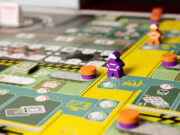 Making a push-your-luck dice game is easy. Even if that’s a straightforward enough statement to make, that doesn’t mean every dice game with this archetype is made the same. There is a lot in the details when making this type of game. In addition, there’s a lot of competition. When a designer wades into these waters, they may be deeper than they realize.
Making a push-your-luck dice game is easy. Even if that’s a straightforward enough statement to make, that doesn’t mean every dice game with this archetype is made the same. There is a lot in the details when making this type of game. In addition, there’s a lot of competition. When a designer wades into these waters, they may be deeper than they realize.
Judging by the theme in Shannon Kelly’s latest design, Lucidity: Six Sided Nightmares, he’s not shying away from these challenges. His new game imagines players as sleepers seeking to escape the world of dreams. If they go too far or dream too deep, they can become a Nightmare, now with new abilities. However, should they collect enough power, they can escape and win their… Lucidity, presumably.
Lucidity: Six Sided Nightmares (Lucidity) is a dice rolling push-your-luck game for 2-4 players. It plays best with 3 players.
Gameplay Overview:
Each player-dreamer in Lucidity will be presented with a player board having multiple locations for dice. Each of these spaces matches a certain side of a die and represents different roll outcomes. The four colors of dice in the game feature these sides in different proportions and configurations.
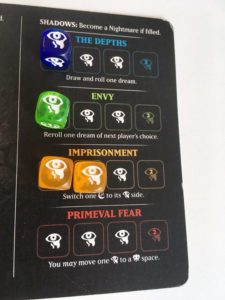
As a player begins their turn, they first choose their level of control which then determines how many dice they can roll (3, 5 or 7). Once they complete a turn, they can take another dice rolling turn with more dice, thereby dreaming deeper. Depending on the results of their rolls, they could find themselves becoming a Nightmare, being devoured or simply exhausting themselves.
The first choice comes after drawing dice from the bag. A player must discard 2 dice back to the bag. The four colors of dice represent four dream types, and, so, should a player choose the dice of Primeval Fear, they have a chance to gain more power or fall prey to Nightmares. After the discard, the player rolls the dice.
Dice results that go towards being devoured or exhausted are resolved first; they could possibly end a player’s turn. Any power symbols left add to a player’s score. Finally, any eye symbols which represent Shadow represent the dark influence of Nightmares on the player. They must resolve the game effects of these one by one. When enough of these are gained, a player becomes a Nightmare and starts negatively influencing other players.
Depending on which type of die caused a player to become a Nightmare, they receive different powers. Usually these involve forcing players to reroll dice or stealing dice from the rolling player. At the end of the game, the player (dreamer or nightmare) with the most power is the winner.
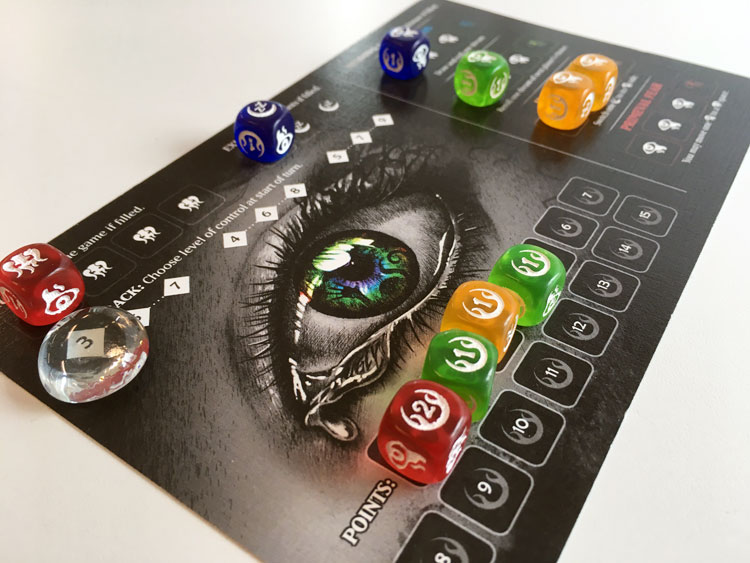
Game Experience:
Gamers out there shopping for a game with an interesting theme should stop and immediately focus on this game, especially if they enjoy the occasional Gothic or dark theme. This is probably the most interesting and unique theme that this reviewer has ever come across. It dives deep into motifs established with Hellraiser and A Nightmare on Elm Street while retaining a Lovecraft meets Salvador Dali style in the art. Shannon Kelly and the collective artists for Lucidity deserve high praise for this.
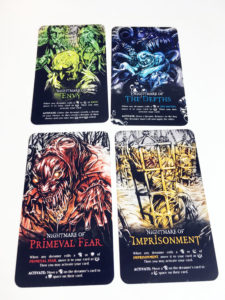
But any review really comes down to whether or not the game is good. The answer here is positive as well. The strategies of working the number of dice rolled as well as which types of dreams to choose is interesting and challenging. However, it is primarily a game of chance and so players will need to succumb a bit to the dark gods of randomness. Especially intriguing is the changed state of players once they become nightmares. Even though the winning goal is the same, players now have new strategic methods.
If there is any particular negative, it has to do with the size of the dice. The game comes with 80 (eighty!) dice in four colors. To keep cost and player mat size down, they’re produced somewhere between 8 and 12mm, smaller than your average RISK die. This makes the custom die faces a little hard to see.
Also, players have the potential of going out on the very first turn due to a bad outcome resulting from an unfortunate draw of dice. This shouldn’t happen often, and the game proceeds quickly. However, because it’s a possibility on even the first play, this reviewer feels this deserves some mitigation.
Final Thoughts:
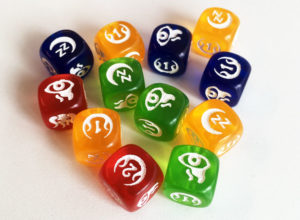
Normally, it takes a lot for this reviewer to take notice of a dice game. They often break the immersion of players into the theme and make players feel like it’s all about mechanisms. Just having a cool theme or a new series of mechanisms won’t be enough to get notice.
Lucidity: Six-sided Nightmares has both and achieved that much-sought-after feat in the Golden Age of board gaming; this is a game players will remember.
Final Score: 4 Stars – An exceptional theme and menu of choices separate this push-your-luck dice game from the masses.
 Hits:
Hits:
• Theme, theme, theme
• Engaging choices with turns
• Multiple game outcomes
Misses:
• Size of dice
• Chance of player elimination






